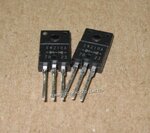boylesg
Advanced Member level 4

- Joined
- Jul 15, 2012
- Messages
- 1,023
- Helped
- 5
- Reputation
- 10
- Reaction score
- 6
- Trophy points
- 1,318
- Location
- Epping, Victoria, Australia
- Activity points
- 11,697
TO-220FP package - 3 leads with centre one common to both diodes.
EN210A 830GEN
No manufacturer logo
Can anyone point me in the direction of a datasheet?
EN210A 830GEN
No manufacturer logo
Can anyone point me in the direction of a datasheet?




